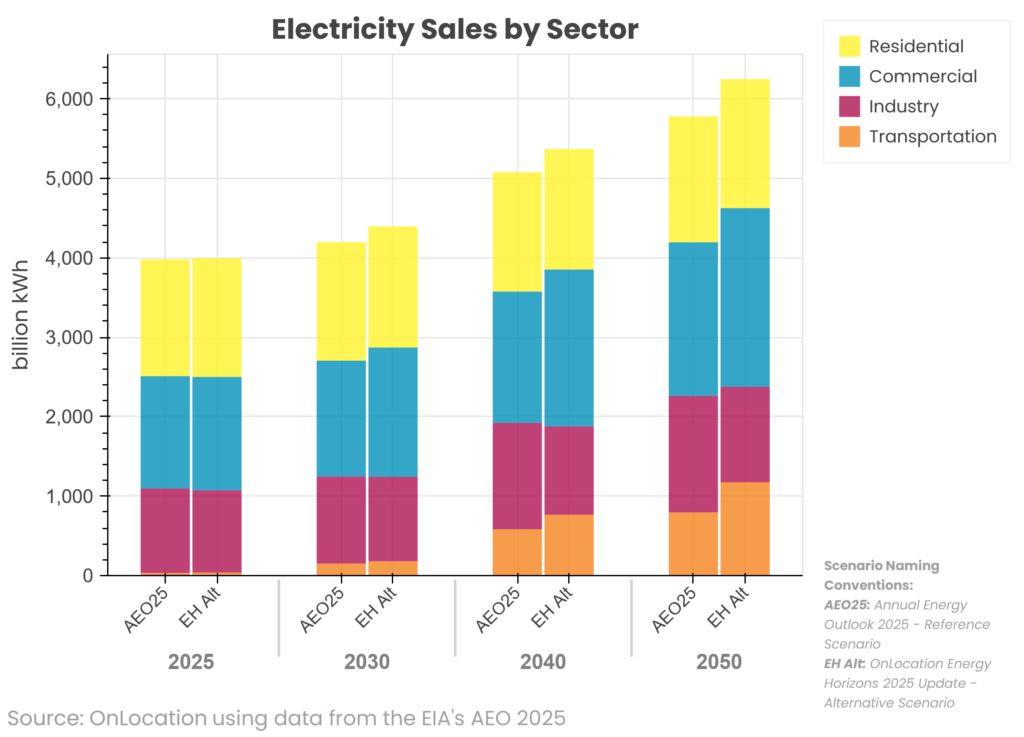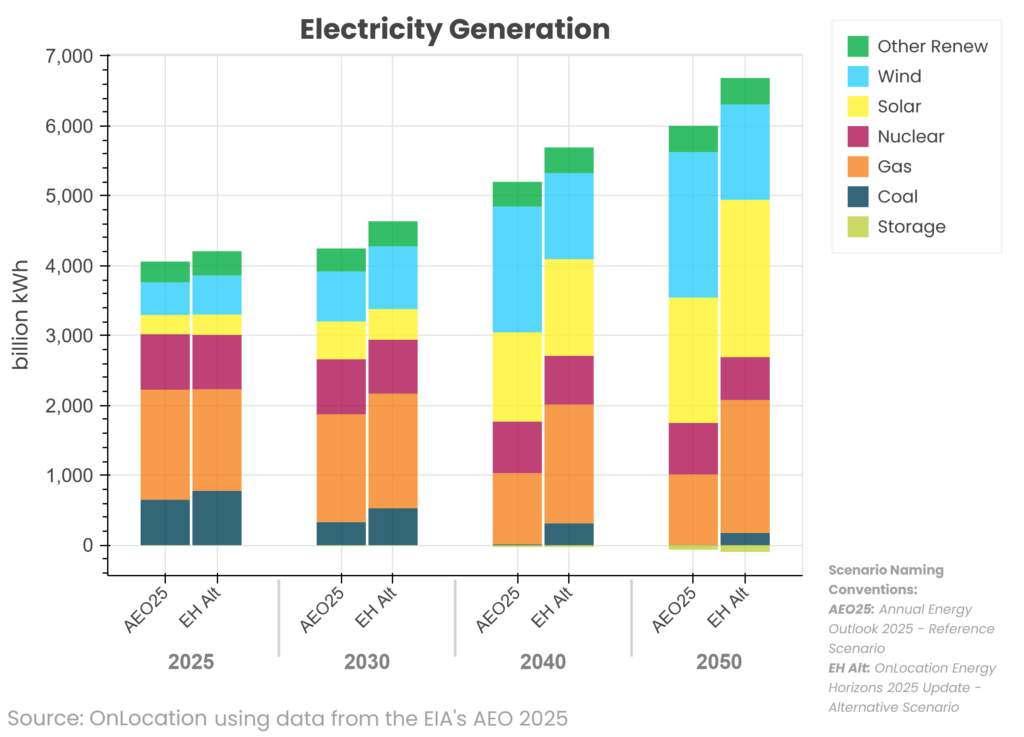Annual Energy Outlook 2025 (AEO 2025)
EIA Releases New Outlook After a Planned One-Year Delay
There has been much anticipation for the release of the U.S. Energy Information Administration’s Annual Energy Outlook (AEO) 2025, as the last release was the AEO 2023. The AEO has traditionally been used as a common benchmark for U.S. energy system projections by various government agencies, research institutions, and industry leaders for decades. Key changes in the AEO2025 include: a leveling off in total energy consumption through 2050, increasing electricity demand, and a revamped National Energy Modeling System (NEMS).
OnLocation has decades of experience in the application and enhancement of NEMS for its clients. OnLocation established its Energy Horizons Series including an U.S. Energy System Projections to 2050 and an advanced analysis on Data Center Growth & Impacts on the U.S. Energy Sector; and created an enhanced NEMS to project the demand for critical materials in the U.S. energy system.
Understanding Changes in the AEO 2025
To evaluate some key results in the AEO 2025 projections, we provide a comparison to our most recent Energy Horizons projections using our enhanced version of NEMS that focuses on significant projected growth in data center energy demand and accounts for new Administration energy policy priorities, including the repeal of EPA Clean Air Act Section 111 greenhouse gas (GHG) regulations for power plants and the Inflation Reduction Act (IRA) tax credits for renewable energy. In contrast, the AEO 2025 Reference assumes more modest growth in data centers and U.S. laws and regulations in effect as of December 2024 that remain until 2050. These key differences result in a broad range of possible outcomes reflected in the two scenarios.
Commercial data centers add significant demand to overall load growth, building on the broader economy-wide electrification trend which includes electric vehicles and heat pumps in buildings occurring in both scenarios as shown in the following figure. These trends are projected to be more modest in the AEO25 Reference case, especially in the commercial and transportation sectors, compared to the OnLocation scenario. Note that for comparison purposes the AEO25 values shown in the chart have been adjusted such that all electric vehicle charging is accounted for in the transportation sector to be consistent with the previous AEO accounting method instead of splitting it between the residential and commercial sectors as is currently reported.

The generation mix utilized to meet the growing demand for electricity is a mix of fossil fuels, renewable energy, and nuclear power in both scenarios. In the AEO25, the share of renewable energy, especially wind and solar generation, expands over time as the share of fossil energy declines due to IRA renewable tax credits and EPA 111 regulations for both coal and natural gas. Coal units without carbon capture retire by 2040 as required by these regulations. In contrast, the OnLocation scenario results in more fossil generation, especially natural gas, and less renewable generation than the AEO25 due to the absence of the IRA and EPA policies. Coal generation declines and renewable generation increases over time but at a much slower rate than in the AEO25.

AEO 2025 Side Cases
In addition to the AEO 2025 Reference case, EIA published two side cases outside of the standard ones that are normally part of the release: Alternative Electricity and Alternative Transportation. The former case assumes the repeal of the EPA Clean Air Act Section 111 rule similar to the OnLocation scenario, while the latter case assumes the repeal of the National Highway Traffic Safety Administration’s Corporate Average Fuel Economy standards, EPA’s vehicle tailpipe emission standards, and CARB ZEV mandates.
Over the last two years, EIA updated NEMS with improved capabilities which include:
- A new Hydrogen Market Module (HMM) to evaluate the emerging potential for hydrogen in the energy economy and represent new IRA tax credits that benefit this sector. OnLocation has previously developed a similar version of this HMM to enhance the AEO23 version of the model, with more technology options than are present in the AEO25.
- A new Carbon Capture, Allocation, Transportation, and Sequestration (CCATS) Module replacing the existing Carbon Transport, Utilization and Sequestration sub-module to better reflect the increased representation of this market outside the power sector.
- A new Hydrocarbon Supply Module (HSM) replacing the existing Oil & Gas Supply Module (OGSM). This new module distinguishes between production on Federal/non-Federal lands, incorporates methane venting penalties from the IRA, and represents carbon capture opportunities from natural gas processing facilities. It also has split decline curves between oil and gas for co-producing wells, among other enhancements.
Conclusion
The release of the AEO each year provides OnLocation with new opportunities to use the latest AEO core scenarios, as well as the updated NEMS model, as the basis for exploring alternative energy policies and technologies for both government and private clients. AEO scenarios and model assumptions reflect existing energy and environmental laws, the current slate of technology options, and historical trends in consumer choice and behavior. These scenarios do not predict what will happen but instead reflect what could happen if current laws and trends remain the same in the future. This provides an excellent starting point to create customized versions of the model to explore the impact of new policies and technologies by changing the underlying assumptions and comparing the model results to the AEO “business as usual” scenarios. Our consultants are uniquely qualified to perform a wide range of energy and environmental scenarios using the NEMS model.
For more information about the NEMS model and integrated energy modeling, visit our website and read our NEMS blogs for answers to common questions about the model, including its capabilities and limitations, the cost of a model run, and the time it takes to perform model scenarios.

